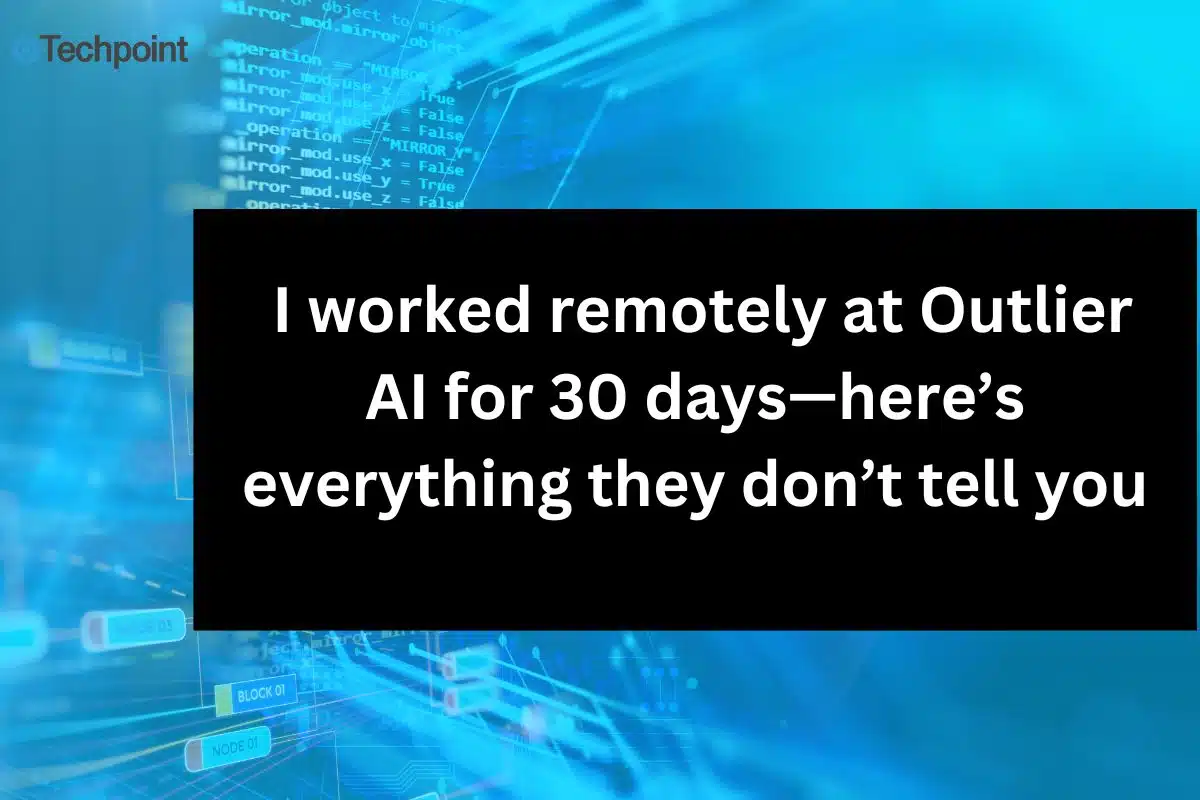Every remote work platform comes into the scene waving figurative placards that scream, “Choose us for flexibility, high rates, and global opportunity!” But how many truly live up to their promises? That’s the question I set out to answer with Outlier AI.
Over the course of 30 days, I combed through its job availability level, pay structures, interface ease of use, onboarding experience, and overall value pillars.
This isn’t a patched-up rush-hour review; it’s an insider tour of what it really feels like to use Outlier AI. Knowing it’s street cred, I know you’ve been wondering whether it’s worth your time; well, I’ve done the groundwork so you don’t have to. Here’s everything I know that you need to know, too.
Key takeaways
- Outlier AI offers the chance to work from home on various AI training and evaluation tasks, making it appealing to those seeking flexible side income.
- Contributors may experience fluctuations in task availability, with some periods of total inactivity where no tasks are available, which can impact earning potential.
- While some users praise the competitive pay rates, there are numerous complaints about payment delays, discrepancies, and poor communication from managerial and support staff.
- The onboarding process includes mandatory training that is often challenging, lengthy, and unpaid for some users.
- Outlier AI only supports 61 countries. Check to see if your location makes the list.
- Despite its drawbacks, Outlier AI can provide valuable insights and skills in AI training and data analysis for those willing to navigate its complexities, making it a viable option for individuals interested in the field.
What is Outlier AI all about?
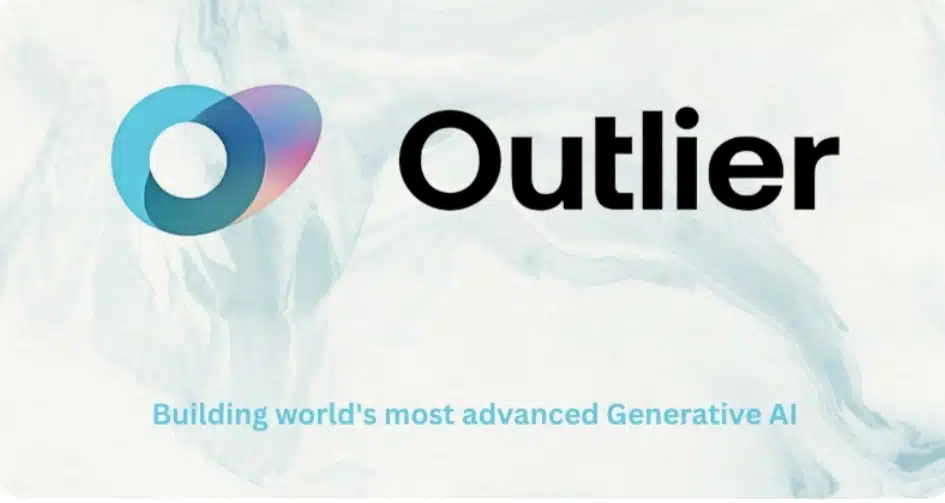
Outlier AI is a platform that employs artificial intelligence (AI) to analyze large datasets and automatically identify patterns and anomalies. Founded by Sean Byrnes and Mike Kim in 2017, Outlier AI aims to help businesses understand their data and evolve the way they interact with their data. In addition to its analytical capabilities, Outlier AI is a remote workplace that connects subject matter experts in Mathematics, English Language, Strategic Management, and SQL with opportunities to train AI models.
The platform engages these experts in projects that involve discrete, highly variable problems, allowing them to interact with AI models as they learn. The overarching goal of this initiative is to build sophisticated generative AI models capable of writing, calculating, coding, and synthesizing data accurately and reliably.
Experts working with Outlier AI can expect to contribute their knowledge in various capacities, including generating training data and evaluating model outputs. This collaborative effort not only enhances the performance of AI systems but also provides experts with flexible work opportunities tailored to their schedules.
Here are the various tasks that Outlier AI provides across multiple fields:
- Writing original and challenging prompts for an AI model and crafting original responses.
- Creating complex Math & Reasoning prompts.
- Teaching LLMs to deliver highly efficient code.
- Ranking AI model responses based on accuracy and correctness.
- Editing AI model responses to ensure accuracy, factuality, and relevance.
- Providing reasoning & logic behind different responses and evaluations.
- Open rewrite assignments where experts provide a starting point or specific context for an AI model to expand upon.
- Multi-modal assignments help train models to generate and classify information from multiple modalities, including images, audio, or video.
- Rating and ranking assignments that ask contributors to identify the best model responses out of two or more options.
To participate as a paid contributor or worker, you need to visit the Outlier AI official website, sign up using a Google account, fill in your education and work experience, verify your identity and phone number, and pass a skills assessment. In the subsequent section, I’ll walk you through a detailed step-by-step process of how I completed mine.
How i signed up and onboarded with Outlier AI
The step to becoming an Outlier AI contributor began with four key stages. Here’s a detailed account of the registration and onboarding process as I remember it:
Account creation
- Visit the Outlier AI Website: First, I headed to the Outlier AI website on my Chrome browser. On opening, I found the interface intuitive and modern. I spent 4 minutes searching for the “Sign Up” or “Get Started” button as peculiar with other platforms I’ve tried, but it was different with Outlier AI. The platform used the “View Opportunities” button as its “Sign Up” equivalent.
Pro tip: Be mindful of this so you don’t spend irretrievable time like me.

- Registration Form: Clicking on “View Opportunities” directed me to a registration form, where I was expecting to choose my location, preferred languages, and area of specification (I went with Content Reviewer).
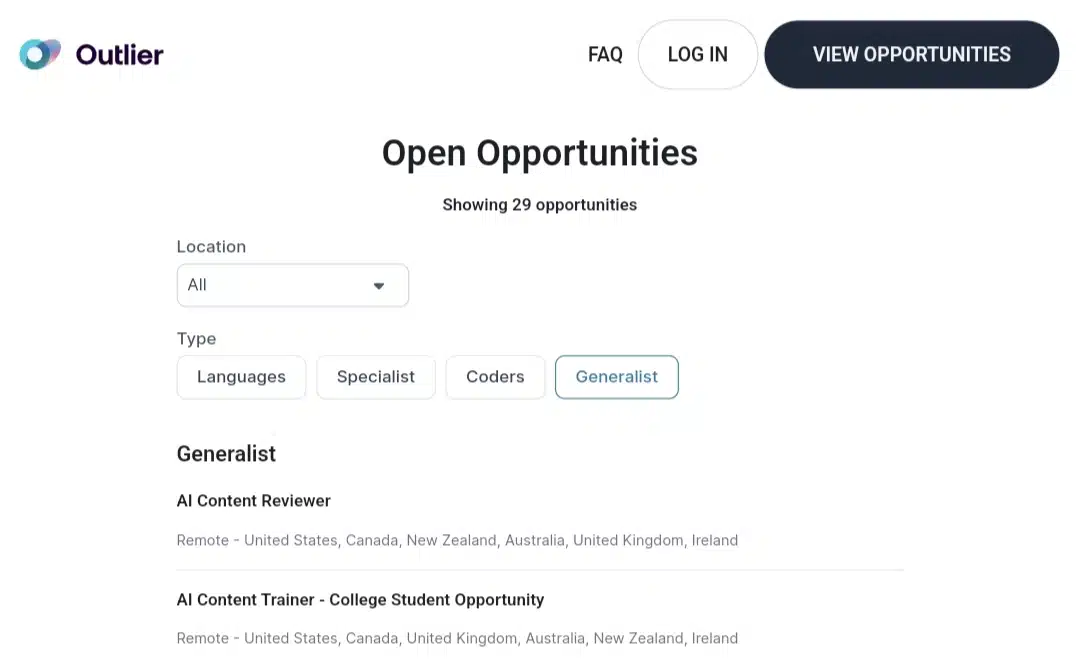
After picking them, the job description and the pay structure appeared.
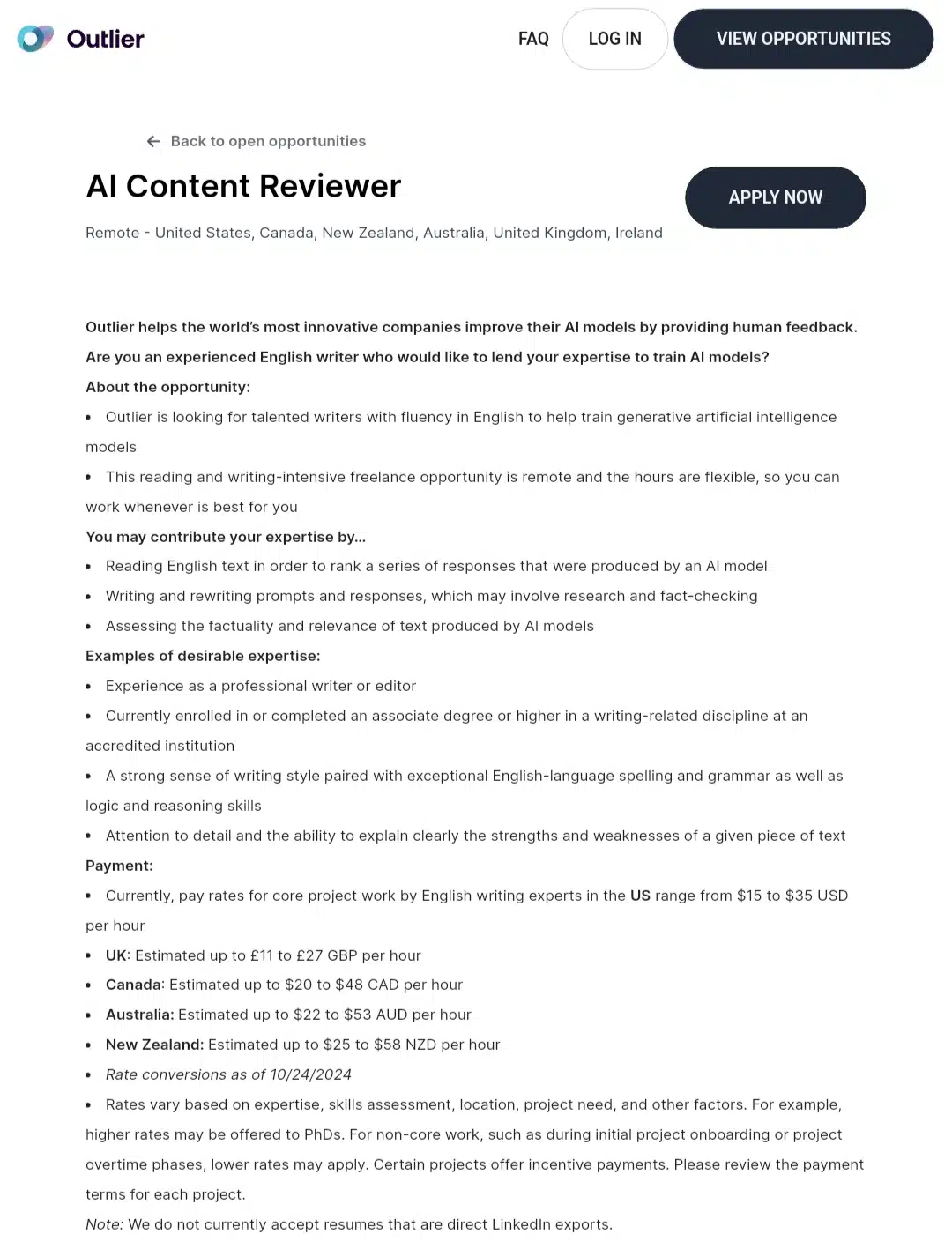
- Terms of Service: After reading through the job description, I clicked on “Apply” at the top right corner of my screen and was given the Terms of Use and Privacy Policy for my consent.
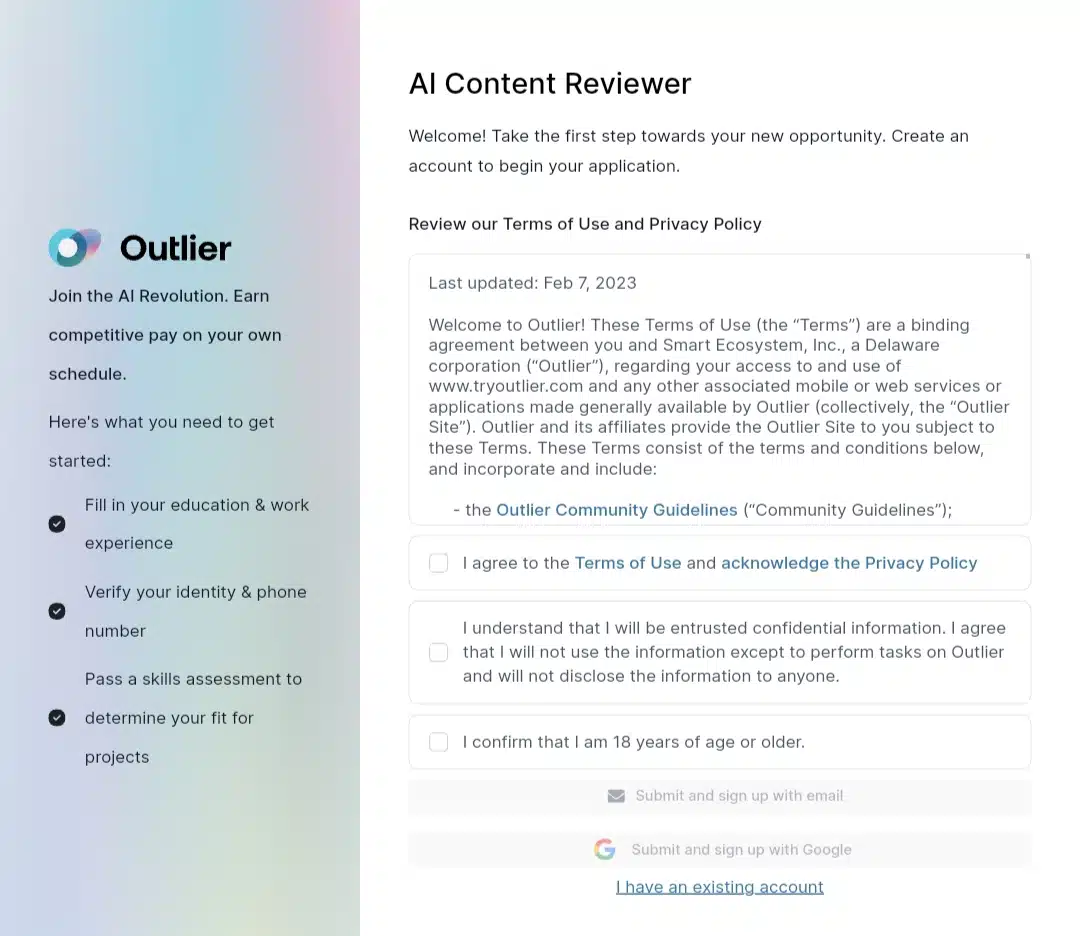
Before proceeding, I reviewed it to ensure I understood the Outlier AI platform’s conditions. Satisfied, I then checked off the confirmation boxes and clicked “Submit and Sign Up with Google.”
I was then asked to insert my email or phone number, and I followed the prompts, keyed in my email, and a password was sent to my inbox.

Profile setup and verification
- Personal Information: I was prompted to complete my profile after creating my account. This involved providing my legal first name, last name, date of birth, country of residence, and phone number.
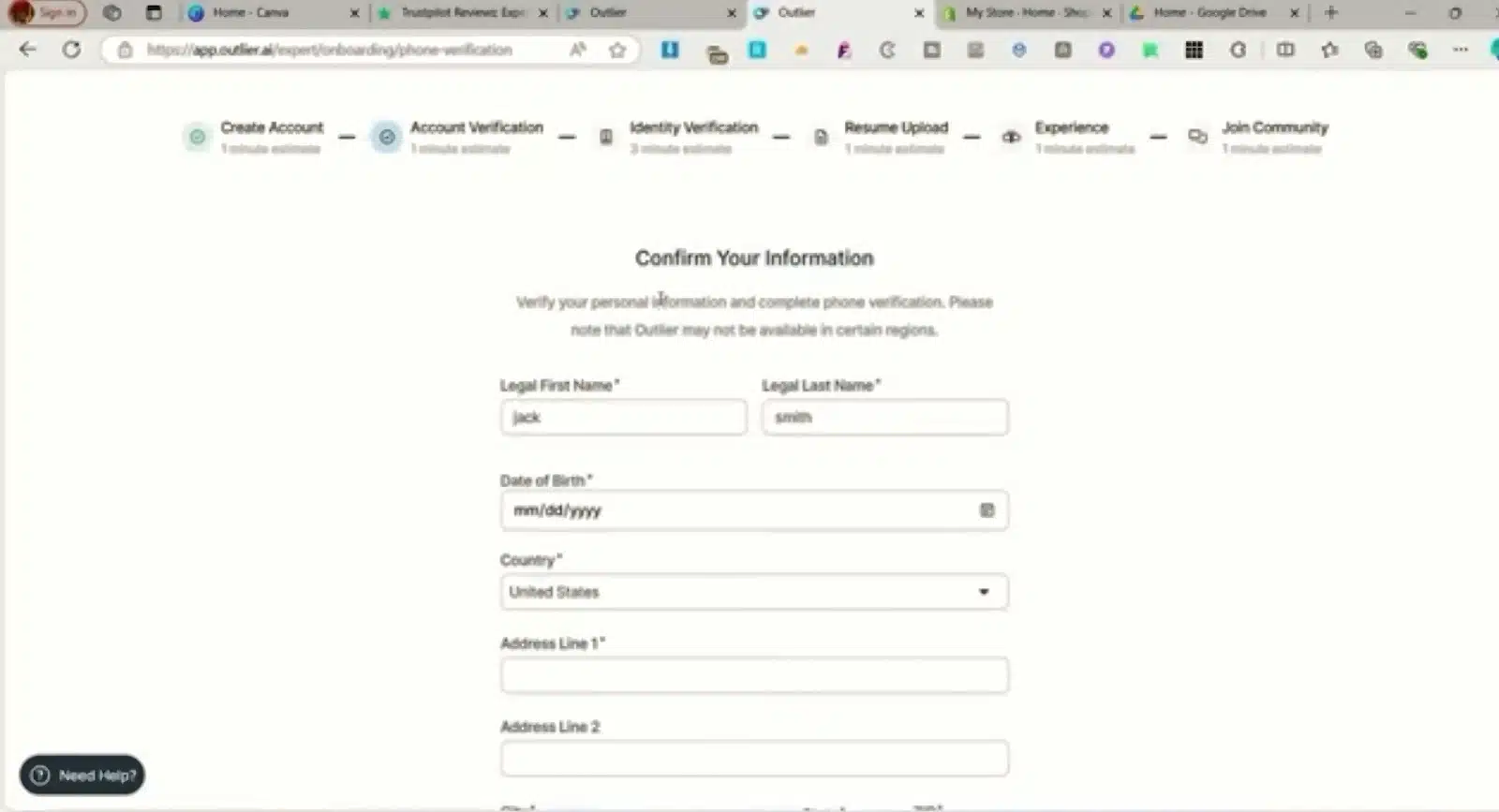
- Account Verification: To verify my account, I provided my email address and phone number. I received a verification email and SMS message, which I used to confirm my contact information.
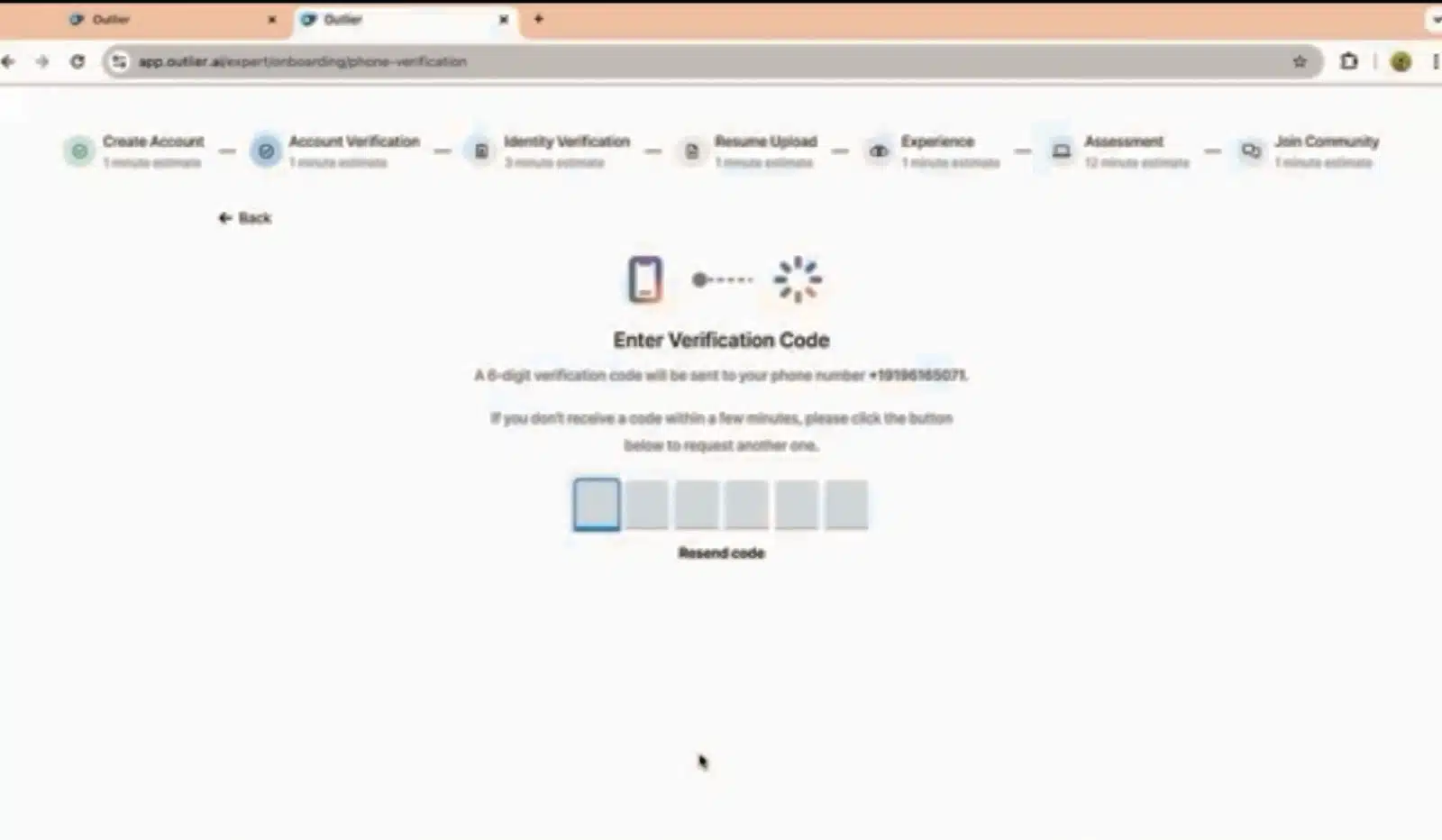
- Identity Verification: The next step was identity verification. I was asked to submit photos of myself, my driver’s license, work permit, or State ID documents to a code sent to my phone. Ensure you have these documents on standby to expedite this step.
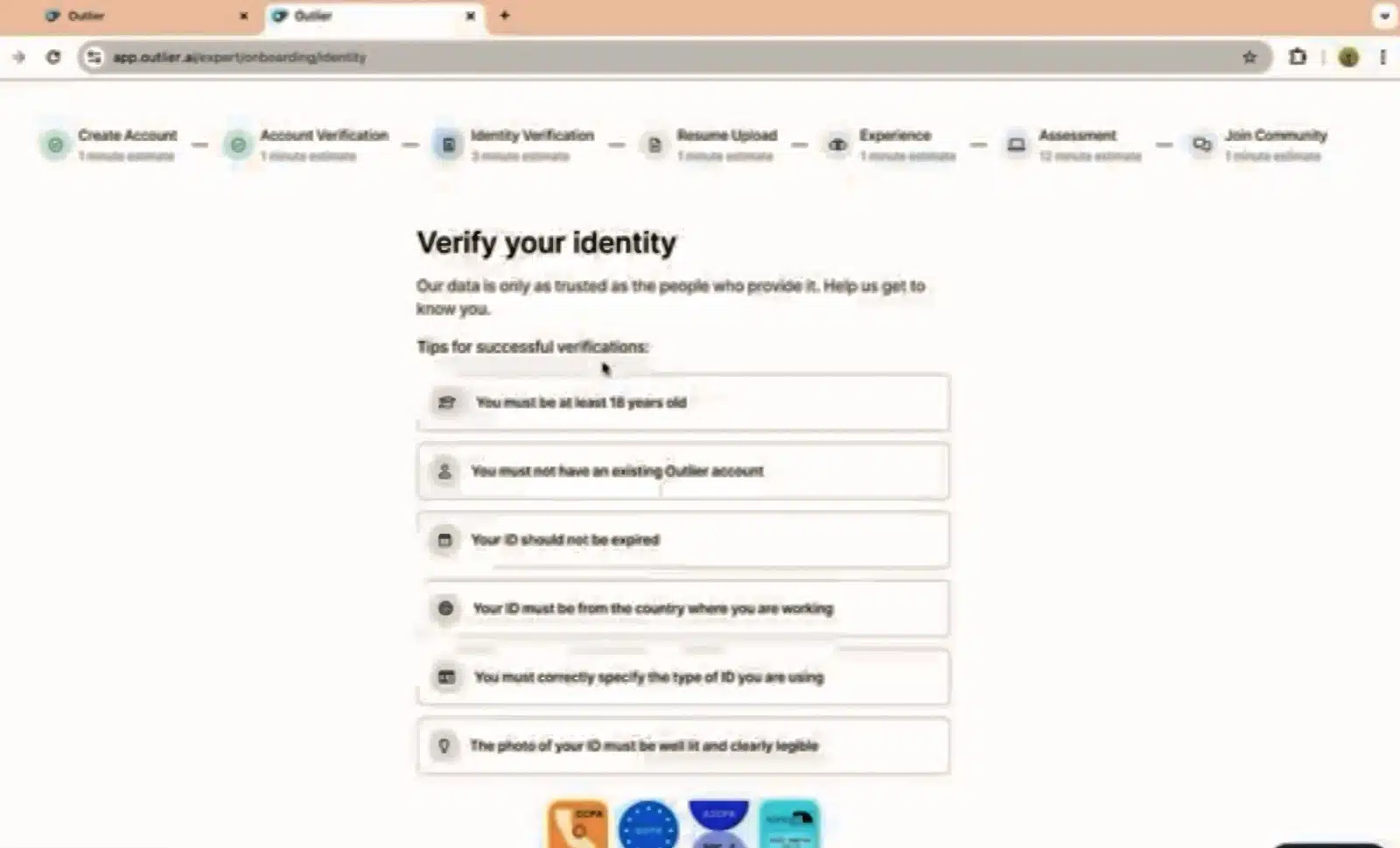
- Resume Upload: As part of the profile setup, I was required to upload my resume and select my areas of expertise.
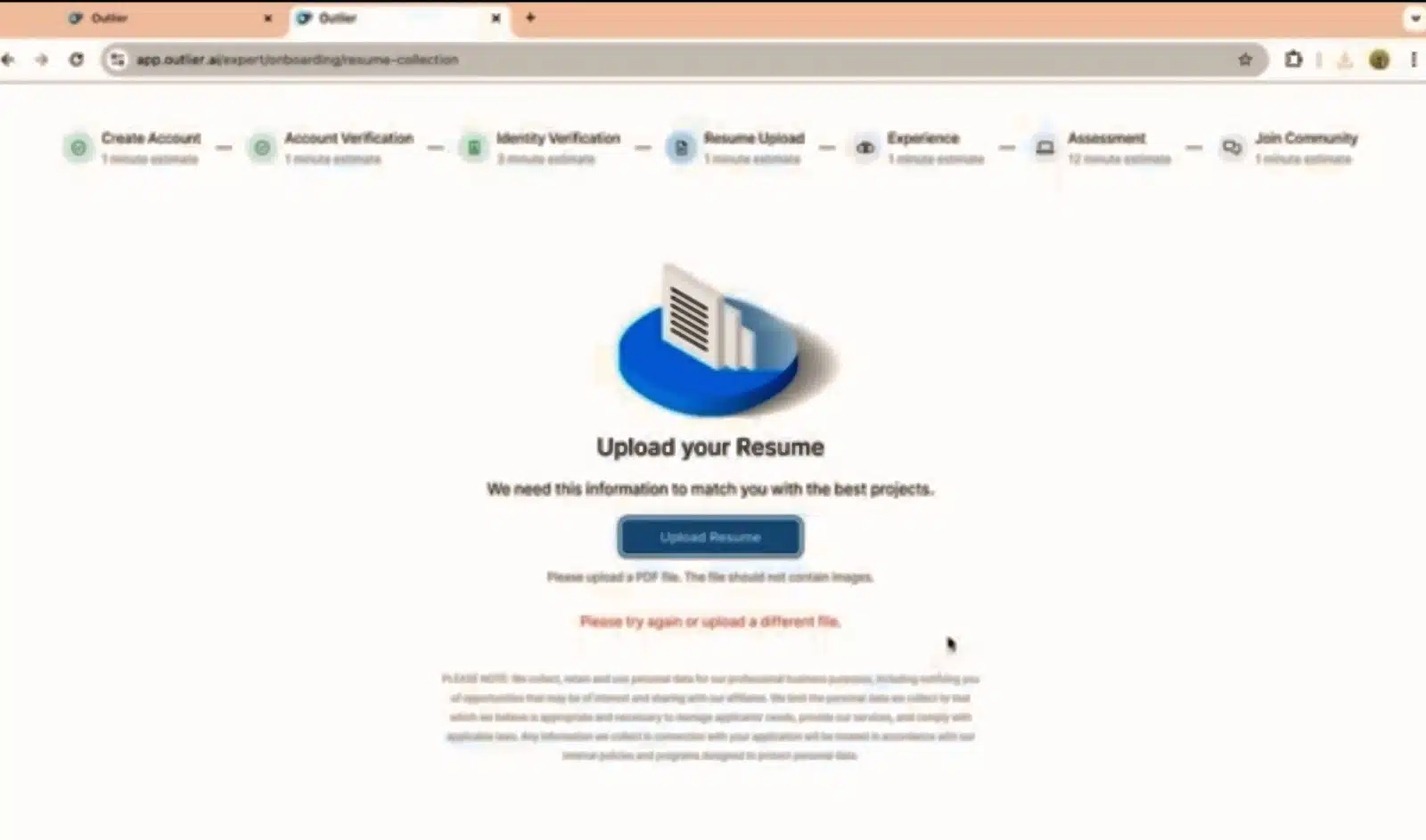
- Join Community: Lastly, I joined a community.
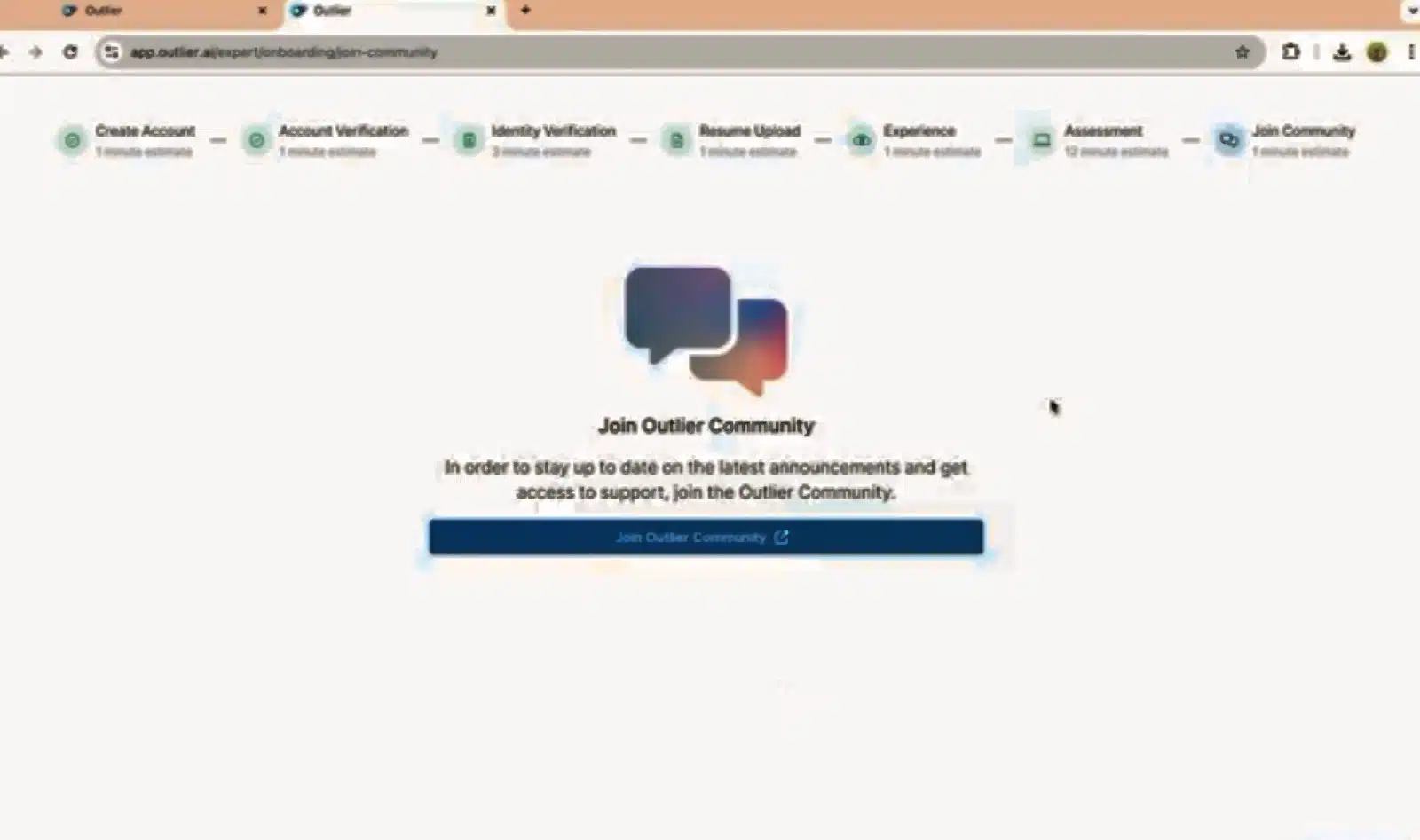
Onboarding Process
The onboarding process commenced with my being added to a squad of contributors in my niche. This squad, led by an experienced squad leader, was designed to help me onboard and learn how to contribute effectively to various projects.
During this time, I went through guided modules, familiarizing myself with the platform’s tools and processes. I also went through a screening exam. Though some domains may also require a virtual interview, mine didn’t. It took between 2 to 5 hours to complete this process.
Onboarding Compensation
- Paid Onboarding: Outlier AI compensates individuals for successfully completing the onboarding process.
- Compensation Details: Compensation may vary depending on the domain area. Some users have complained bitterly about never getting credit for this stage. I got $10 for mine. Reviewing the details in the job domain for specifics and keeping your expectations low is important.
For the most part, the registration and onboarding process was a bit lengthy and challenging. Still, it was designed that way to guarantee that contributors have the necessary skills and knowledge to contribute effectively to the Outlier AI platform. Training-wise, I range it from simple to complex. Simple because if you take the time to understand the instructions and guidelines provided for each task, it informs accurate results and complex since it’s more than mindlessly clicking through close-ended and easy answers.
Outlier AI pay structure
Let me explain how Outlier AI will likely compensate you as a signed-on contributor.
The first thing you need to know is this: Pay grading with Outlier AI is also multifaceted, as tasks are influenced by your skill set, geographic location, and level of consistency with which you allocate available tasks.
Structurally, Outlier AI mainly uses a fixed hourly pay rate. They go right ahead to clear each task based on a rating from your active engagement, research, fact-checking, and accurately answering the prompt. Note that your ratings must rank high at the end of this assessment to pass the criteria. Some users have reported earning decent hourly rates, with potential earnings ranging from $15 to $40 per hour for specialized gigs such as math projects or advanced language tasks. However, more straightforward tasks like reviewing AI-generated text may pay closer to $10 or $15 per hour. A constant workflow can result in weekly earnings of around $250.
To summarize the earning opportunities on Outlier AI, I formulated this table:
| Factors | Impact on earnings |
| Skill Level | Higher skills (e.g., Ph.D., programming) = higher pay rates. |
| Task Type | Specialized tasks (e.g., math, coding) = higher pay; basic tasks (e.g., text review) = lower pay. |
| Work Consistency | Consistent work = steady income; sporadic availability = fluctuating income. |
| Location | Pay rates vary by country. |
| Time Investment | More hours worked = higher potential earnings, which can lead to exhaustion. |
| Passing Skills Assessment | A pass allows you to access the project |
| User’s attitude to work | Reliable research, fact-checking, and answers get your tasks highly rated. |
| Quality of your work | Delivering high-quality work in high volume quadruples earnings. |
| Transparent communication | Regarding project requirements and feedback. |
This table’s content is all you need to know to inform your earning potential.
Outlier AI compared with other remote work AI platforms
For reasons of diversified conclusion, let’s consider two other AI remote work platforms, Appen and DataAnnotation Tech, and how their payment models pit against Outlier AI.
| Factors | Outlier AI | Appen | DataAnnotation Tech |
| Pay Structure | Hourly-based rates vary by expertise and task complexity. For example: $22.09 per hour for AI Writing Evaluator. $41.71 per hour for Software Engineer | Task-based pay depends on task type and location. For instance: The average data collection salary is around $14/£10 per hour.The average hourly pay for Appen Transcription salary is $22.63 in the US. | Project-based rates vary widely depending on task type and client requirements. For this reason: The average hourly pay for a Data Annotation Tech job in the US is $22.84. $16.81 per hour for Personal Care Assistant. |
| Payment System | Weekly payments via PayPal or AirTM. | Monthly payments via Payoneer, PayPal, or direct deposit. | Payments are typically made upon project completion via PayPal or direct bank transfer. |
| Minimum Threshold | $10 | $10 | $20 |
| Earning Potential | $200–$2,000/week, depending on hours worked and expertise level. | $50–$500/week, depending on task availability and time invested. | $100–$1,000/month depending on project type and completion speed. |
| Work Consistency | Inconsistent; task availability depends on project demand. | Moderate; tasks are often available but may depend on region and qualifications. | Variable; availability depends on client demand and contributor expertise. |
| Skills/Qualifications | Requires subject matter expertise (e.g., Math, English, SQL) and passing a skills assessment. | Open to general contributors but higher pay for skilled annotators or language experts. | Open to general contributors; higher rates for specialized knowledge (e.g., coding). |
| Support System | Mixed reviews; slow response times reported by some users. | Generally responsive; provides online resources and email support for contributors. | Limited support; relies heavily on self-guided resources and FAQs. |
Pro tip:
Outlier AI is the better option if you’re a highly skilled expert seeking higher hourly rates and engaging tasks in AI development.
Consider Appen for general contributors or those looking for steady annotation work across multiple data types with moderate pay rates.
If you prefer project-based work with flexibility in task types but are okay with variable income patterns, explore opportunities with DataAnnotation Tech.
My working experience with Outlier AI
Before I got to work, I thought my time with outlier AI would be pretty laid-back and mono-dimensional. I thought, “Okay, I’ll be teaching robots to be less robotic,” but it was nothing like that. Instead, I was thrown into a multifaceted workspace filled with a variety of tasks that challenged my skills and provided valuable insights into the niche of AI training. Here’s a detailed account of the tasks I worked on.
AI Model Training
One of my primary responsibilities involved evaluating AI-generated responses. The platform presented me with pairs of AI-generated answers, and I had to select which one better addressed the original query. What struck me was the subtle differences. Sometimes, both responses seemed correct at first glance, but then I’d notice one had slightly better reasoning or explained a concept more clearly.
I remember one particularly challenging comparison about quantum computing, where I spent nearly 10 minutes weighing the technical accuracy against the clarity of the explanation. The interface used a simple thumbs-up/thumbs-down system, but the responsibility felt weighty—knowing my choices would help shape how the AI communicates in the future.
Image Annotation
The image annotation task was surprisingly engaging at first. The platform showed me various photos, and I had to draw precise boxes around objects and label them. I recall working on a series of street scenes, carefully outlining cars, pedestrians, and traffic signs. The interface’s satisfying snap-to-edge feature made my boxes look clean and professional.
Data Validation
This task tested my patience like no other. I faced spreadsheet-like grids filled with data points that needed verification. One memorable dataset contained customer service interactions, and I had to flag instances where the sentiment analysis seemed off. The interface highlighted potential inconsistencies in yellow, which helped, but I still had to carefully read each entry. I found myself developing a rhythm, though: scan, evaluate, flag, next. I felt almost like a data detective looking for clues of mismatched information.
Content Generation
The content generation tasks gave me creative freedom within structured boundaries. The platform provided clear guidelines: “Write product descriptions between 50-100 words, highlighting key features and benefits.” I remember crafting descriptions for specific gadgets, trying to make each unique despite similar features. The interface had this helpful word counter that turned green when I hit a keyword and red when I strayed outside the limits. It was like solving a puzzle, fitting all the necessary information within those constraints while keeping the language unique and engaging.
Multi-Modal Assignments
These were the most intellectually stimulating tasks. One project required me to match audio descriptions with images and verify their alignment. The interface displayed an image on one side and played the audio on the other, with a simple matching mechanism between them. I particularly enjoyed working with a set of nature documentaries, ensuring the narration matched precisely what was happening in the visuals. The challenge came when dealing with technical subjects where precision was crucial.
Open Rewrite Assignments
For these tasks, I chose topics I knew well, like technology and football. The platform would show a basic prompt like “Which country won the 2010 World Cup?” and I would expand it into a detailed, expository article. The interface had this neat split-screen setup showing the original prompt on one side and my expanded version on the other. I found myself naturally incorporating my own experiences.
Rating & Ranking
This task required the careful consideration of multiple AI responses simultaneously. The interface would typically show 3-4 responses side by side, with a drag-and-drop ranking system. I remember one session focused on comparing different explanations of climate change, where I had to consider both scientific accuracy and accessibility to a general audience. The platform used a star rating system and ranking, which helped me quantify the quality differences between responses. Sometimes, the differences were so subtle that I had to read each response multiple times before making a decision.
In a nutshell, I was able to get all these tasks done due to the relatively intuitive nature of the platform after going through an initial learning curve during onboarding, which familiarized me with task guidelines and expectations. However, I would advise against relying on Outlier AI as a consistent income source since occasional drought seasons have no steady flow of assignments.
What i liked about Outlier AI
Throughout my time working with Outlier AI, these positive aspects kept me hooked:
- Skill development: Each task challenged me in different ways, allowing me to expand my skill set in areas like data analysis, creative writing, and critical evaluation.
- Tech exposure: By training these AI, I got firsthand knowledge of how AI behaves and adapts and can hold a conversation about it.
- Flexible scheduling: The ability to choose when and how much I worked allowed me to balance this role with other personal commitments effectively.
- Pay process: Payments were consistently processed weekly through PayPal or AirTM. Also, Outlier AI uses a transparent system, which makes it easier to track my earnings and process payments.
What i didn’t like about Outlier AI
However, there were also challenges:
- Inconsistent task availability: As mentioned earlier, there were times when tasks were scarce. This inconsistency made it difficult to rely on Outlier AI for steady income.
- Repetitive nature of some tasks: Certain assignments felt monotonous over time, particularly those involving simple data annotation or validation.
- Support limitations: When issues arose—whether related to task guidelines or payment discrepancies—customer support was not always responsive or helpful, which added frustration during critical moments.
- Privacy concerns: Scanning my ID for verification made me anxious due to the fear of data misuse. I’d love to sign in with Google only instead.
- Payment concerns: While payments were generally punctual, I did encounter minor discrepancies regarding payment rates for specific tasks. Clarification was eventually provided, but it required persistence and patience.
- Long assessment and onboarding process: This was lengthy, and not every new user will have the patience to complete it.
Who should consider working with Outlier AI?
Based on my experience, several groups of individuals may find Outlier AI particularly beneficial:
Remote workers seeking flexible side income
Suppose you juggle multiple commitments—studies, family responsibilities, or other freelance jobs—and have no time for full-time employment. In that case, Outlier AI will provide you with a flexible work environment. This means you can choose tasks that fit your schedule and submit them on your deadline. This flexibility was the “it” factor for me; I could work during my most productive hours, take breaks when needed, and pursue other interests.
Individuals comfortable with Data Annotation and AI training tasks
If you have a knack for detail-oriented work and enjoy engaging with technology, you’ll likely thrive in this environment since tasks often involve data annotation or evaluating AI-generated content, which can be intellectually stimulating. Personally, the opportunity to constantly learn new things about AI and its applications kept the work fresh and interesting.
Users who don’t rely on a consistent paycheck
Insider secret? If you need a steady paycheck to meet your financial obligations, this might not be your best option. However, if you can manage your finances without relying solely on this income stream, Outlier AI can be a rewarding side hustle.
People in the 25-34 age range
The largest age group of visitors to Outlier AI is 25-34 year olds. This wasn’t a wild guess, but it was supported with data from similarweb. This demographic—which I fall into—may find the platform and its tasks particularly appealing or user-friendly.
Those interested in contributing to ethical AI development
Since Outlier AI aims to train AI models to be safer, more reliable, and more accurate, being passionate about this cause will make you feel fulfilled, contributing to that goal.
Final thoughts: is Outlier AI worth it?
Working with Outlier AI presented both advantages and disadvantages. On the positive side, the platform offers flexibility, various tasks, tech exposure, and highly consistent payments. However, inconsistent task availability, occasional lack of support, and unstable pay rates are notable drawbacks.
I would recommend Outlier AI for those seeking flexible, part-time, remote work opportunities. However, if you tend to be uncomfortable with strict ID verification processes and are looking for a reliable, full-time, stable income, then you might want to consider other generative AI training remote platforms or opportunities with more predictable task flows and dependable managerial and communication support.
If you’ve had any personal experiences with Outlier AI, please share them in the comments below. Your experience can help others make informed decisions. Also, if you have any questions, do ask away! Subscribe to the website to get alerted when more of my AI tools review drops.
FAQs about Outlier AI
As I delved deeper into Outlier AI, I encountered several frequently asked questions that potential contributors often have:
Is Outlier AI legit or a scam?
- Outlier AI is a legitimate platform connecting subject matter experts with projects to develop advanced generative AI models. While many contributors report positive experiences, there are also concerns about task availability and support responsiveness. It’s essential to weigh these factors before committing.
How do you get paid on Outlier AI?
- Payments are typically processed weekly through PayPal or AirTM. Your earnings depend on the tasks completed; some pay more than others. I found the payment process to be reliable overall, but keeping track of your earnings and ensuring they align with what you expect is crucial.
Are tasks available worldwide, or are they region-specific?
- Outlier AI aims to provide opportunities globally; however, the availability of specific tasks may vary based on regional requirements and project needs. While I could access various assignments from my location, some contributors reported limitations based on their geographical area.
What’s the minimum payout threshold?
- While specific figures vary, the minimum payout threshold is around $10. This means you need to accumulate at least this amount before requesting payment. It’s relatively low compared to other platforms, making it easier to access your earnings.
How many countries does Outlier AI support?
61 countries. These include the United States, Mexico, and several countries in Central and South America, such as Argentina, Chile, Puerto Rico, Peru, Colombia, Belize, Costa Rica, the Dominican Republic, El Salvador, Guatemala, Honduras, Nicaragua, and Panama.

